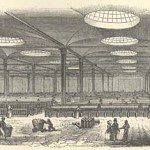I have been working on the contents of this and the many following articles for several months. It has been hard to make the decision to publish, as I feel I will find more information. But I could work on it forever! I know I have shared information before on the industrial revolution in Schaghticoke, beginning about 1800, but I don’t feel I have emphasized it enough- and, as you will see, I have a lot more to say. To prepare for this I visited two great museums: the National Park at Lowell, Massachusetts, and Hanford Mills Museum at East Meredith, NY. I wanted to really understand the operation of mills, from water to finished products, and both places let the visitor see that in action. I recommend both places to you. Hanford Mills is near Oneonta, very accessible to us. Lowell is filled with textile mills and the canals and machinery needed to operate them. Hanford Mills has a grist and saw mill plus several other wood working machines which operate off the same water wheel, or with a steam boiler.
Read the entire article in the Aug. 7 edition of the Express.

